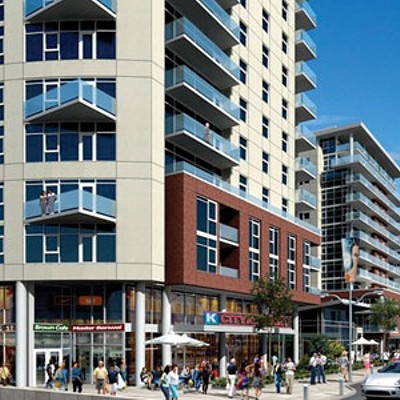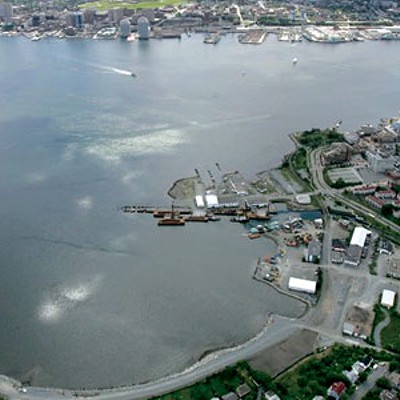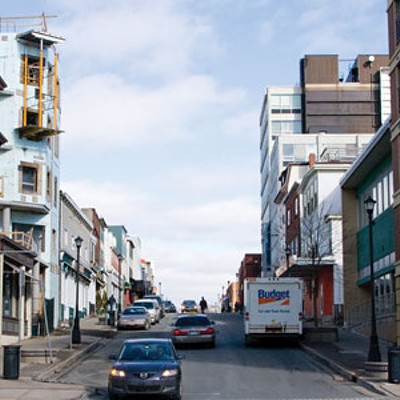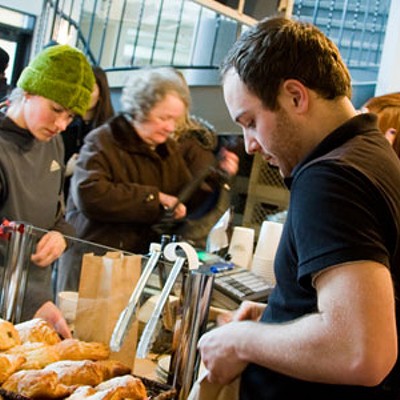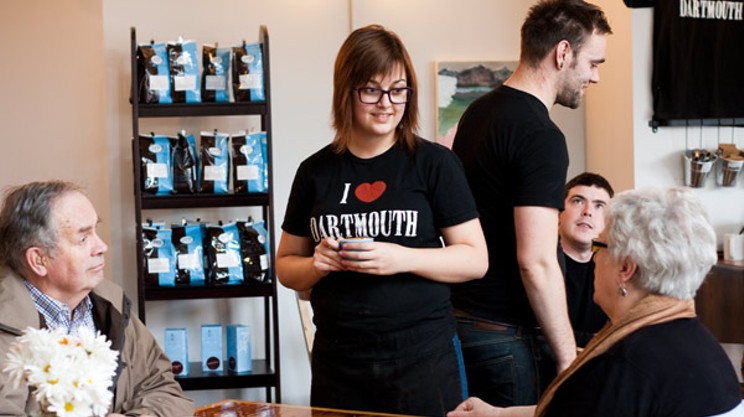The gleaming, stainless-steel kitchen at Dartmouth cafe Two If By Sea is a blur of activity, with a half-dozen young, black-clad employees milling about behind a panelled counter. Tattooed arms dole out espressos, dive into glass jars to retrieve gooey cookies and dig through baskets for croissants the size of footballs. Customers wait patiently in a lineup that extends past a winding staircase leading to an unfinished upstairs space. Those who have already been served sit at tables topped with small bottles bearing single flowers.
The cookies are especially popular today. A little boy wrestles with a chocolate-chip concoction nearly the size of his face, the same item that two female college students in thick-rimmed glasses have decided to share. They discuss an upcoming art show until they're politely interrupted by Zane Kelsall, co-owner of Two If By Sea, who's found a moment to step out from behind the counter and ask how the coffee is.
Kelsall is proud of his coffee. He and business partner Tara MacDonald are also proud to have chosen Ochterloney Street in downtown Dartmouth as the location for Two If By Sea, which opened late last fall---especially since a chorus of naysayers told them an upmarket java joint on "the dark side" couldn't last.
"We had someone come in from a local paper and make a bet with us that we'd be out of business by the end of January," Kelsall says with relish. "It looks like he's going to have to pony up."
Kelsall claims Two If By Sea's sales are competitive with his former employer Steve-O-Reno's in downtown Halifax, and the crowd around us---a mix of artsy students, moneyed middle-agers and moms pushing strollers---certainly indicates a strong market for lattes. He then points to a young couple sitting behind us---a couple that regularly ferries in from Halifax---as evidence that word of his cafe's gourmet joe and buttery treats has crossed the harbour.
Halifax hipsters spending an afternoon in downtown Dartmouth? Kelsall thinks this once-unfathomable phenomenon could become an everyday occurrence. He and MacDonald believe in the potential of the neighbourhood, potential represented by the upscale Founders Corner condominium development with which they share the corner of Ochterloney and Wentworth. Potential further suggested by King's Wharf, a massive mixed-use development project scheduled to break ground near the Dartmouth Marine Slips within the next couple of months.
"It wasn't the reason we opened here, but it was a selling point," Kelsall says of King's Wharf. "When we were doing our marketing research, we realized that was going to bring more than 2,000 new residents in the next few years to the downtown core.
"We wanted to get in on the ground level."
Kelsall feels Dartmouth is ready to shake off decades of stagnation to become a hub of social and economic activity. A place where scenesters can satisfy their appetites for food, culture and complicated coffee, and locals emulate the "Proudly Dartmouth" slogan written on the sandwich board outside Two If By Sea. They've already won the reporter's money, but Kelsall and MacDonald are betting bigger stakes on just such a future.
Whether that bet pays off will depend largely on Francis Fares, the president and CEO of Fares Real Estate Inc. and the developer of King's Wharf.
On a cold Friday afternoon, Fares looks out from his office window at the King's Wharf sales building and sees a winter sun that sparkles off the water and paints the walls of the room a gauzy orange-yellow. The optimistic light matches the mood of the soft-spoken developer. With his project, which will cost up to $500 million and take up to a decade to complete, Fares is promising a dramatic makeover of the land surrounding the Dartmouth Marine Slips. His plan is to transform the unsightly space between Alderney Drive and the waterfront into a neighbourhood teeming with new residents and businesses. While the most iconic element is a 30-storey condominium tower, the project includes several smaller condos, office buildings, a hotel, a cruise ship terminal, a marina and retail space.
"We're hoping it will be the hub, the centre, the downtown of Dartmouth, where people can live, work and shop," says Fares of his development, one of largest in the history of HRM.
Fares, along with Kelsall and others, believes the spillover of residents, tax dollars and jobs from King's Wharf will revitalize the entire downtown area, including a main artery, Portland Street, that is currently a gallery of weathered old buildings, empty storefronts and the odd shiny new business. Once he obtains the building permits for the first phase of his development, which is comprised of three condominiums and an office building, Fares will begin making alterations to a town starving for change.
"Dartmouth has been neglected for a long time," Fares says. "I think it's Dartmouth's time in the next 10 years."
Despite all the sunny talk, there are some troubling clouds obscuring the view of Dartmouth's future. The very changes that could boost the city's fortunes threaten to uproot its most vulnerable residents, bringing dramatic consequences to those whose lives depend most on routine. It's also unlikely that the hip, happening neighbourhood envisioned by Kelsall will emerge out of a heavily condo-fied downtown.
With his crisp suits and deep pockets, Fares is certainly the kind of person who can bring new buildings, new people and new money into Dartmouth. Less certain, however, is what new identity will come with them.
The Among Friends Social Club shares its main entrance with one of the several tattoo shops that line Portland Street, and with nothing but a small, black-type sign to announce itself, it's easy to miss. Chances are many people who live or work in the downtown area aren't even aware that it's here, or how important it is to the 50 or 60 people suffering from mental illnesses ranging from anxiety to schizophrenia, who come in every day to eat, watch television and socialize.
Patrons do all this in a room not much bigger than a large one-bedroom apartment, a busy space occupied today by about a dozen members. It's a quiet bunch---whispered voices are drowned out by a blaring television---but friendly. A thin, silver-haired man clad in third-hand clothing and a welcoming gap-toothed smile leads me to the back of the building, to a tiny storage room that Beverly Cadham has converted into an office.
Cadham, program co-ordinator at Among Friends, worries that her members, many of whom live in the group homes and rooming houses that dot the downtown side streets, will not be able to maintain this shelter if property values and rents increase and developers buy up affordable housing. All of the members are on social assistance, collecting a maximum of $535 per month.
"If it's $25 more or $10 more [for rent], that's coming out of what they would spend on food, clothing or [prescription] drugs," she says. "If the rent's going up but the monthly income's not going up, if people are selling off the rooming houses and housing blocks and leaving less and less affordable housing, that's where your whole homelessness issue comes into play.
"If you take away more of that affordable housing, where are people going to go?"
Being forced to relocate is a trauma the club members are familiar with. Four-and-a-half years ago, Among Friends had to vacate its former home on Ochterloney Street because the building did not meet environmental standards. The club shifted its base to the Nova Scotia Hospital in Woodside, about three kilometres to the south---an inaccessible location for patrons whose illnesses and financial restrictions precluded complicated cross-town journeys. As a result, Among Friends lost about three quarters of its membership before moving back downtown two years ago.
Up the street at Our Thyme cafe, shop manager Mary Young and Barbara Darby, secretary of the board at the Elizabeth Fry Society, echo Cadham's concerns. The Society helps women at risk of a run-in with the criminal justice system forge better lives, in part by providing jobs and training at Our Thyme.
With its corner fireplace and service provided today by a petite, greying woman with a gentle, attentive demeanour, Our Thyme gives off a cozy grandma's-house vibe. Our server is one of a dozen employees here, a group of women with histories that include prison sentences, anger management classes and lack of housing.
In addition to Our Thyme, the Society also operates a rooming house on Tulip Street that provides women with stability in the form of short-term shelter. Without it, the nine current residents of the house, women working hard to put their troubled pasts behind them, would face yet another obstacle.
"If affordable housing gets pushed out from the core, our clients will have trouble getting in to us to use our services," says Darby. Among these services are outreach and emergency food and clothing programs used by approximately 60 women in Dartmouth each month.
Darby isn't opposed to condo developments such as King's Wharf. She just hopes a more privileged crowd accepts and interacts with citizens from a harder-luck background. "I think a mix is good for everybody," says Darby.
Karen Goudie also believes Dartmouth can succeed as a mix of new and old, of high and low-income residents. Goudie is coordinator at Feeding Others of Nova Scotia, a soup kitchen that operates out of the Margaret House heritage property on Wentworth Street, and feeds and clothes roughly 3,000 of Dartmouth's less-fortunate residents each month. She says she's experienced few problems since Founders Corner and Two If By Sea opened across the street and that a bigger, richer community could mean more support for her organization.
"You have to look at it in a positive way," she says. "I hope it's a healthy integration, and I think it will be."
But there is a fine line between positive thinking and wishful thinking. Hugh Millward, professor of geography at Saint Mary's University, says gentrification of the kind that appears imminent in Dartmouth "tends to take over a whole area and you tend to get a displacement of a lot of poorer people and people who are renting. What tends to happen is that they get pushed further out into suburban areas that are in decline."
Goudie's notion of a "healthy mix" would be more plausible if the HRM had regulations or incentives to ensure private developers included affordable housing in their plans But while a few city councillors are making a push in this direction, no such laws are currently on the books.
Gloria McCluskey, councillor for downtown Dartmouth, is one of those officials who would like to see the city require developers to provide affordable housing in their projects. But she also feels downtown Dartmouth has too high a concentration of rooming houses, and that development geared to higher-income residents is a winning move for the neighbourhood right now.
However, the town's losing reputation has actually helped it stay affordable, and unless the community preserves sanctuaries for its most vulnerable citizens, the people left out of the winners' circle will be those who can least afford to lose.
As Our Thyme's Young puts it, "I don't think anything would ever be a win for everybody."
When Fares paints a verbal portrait of the people he expects to populate his condos, he speaks of empty nesters and young professionals. For such buyers, a clean sweep of Dartmouth's seedier elements might sound appealing. But even those fortunate enough to afford to take up residence in a re-imagined downtown should carefully consider what they're getting into. However noble Fares' intentions may be, time and money have a way of throwing even the best of plans off course.
There have already been significant changes to the King's Wharf project, in particular the decision to alter the order of construction from the original two-phase plan agreed to by the Halifax Regional Council and the Harbour East Community Council in 2008. Initially, the first phase was to include a small office building on Alderney, the tall condo tower, a public park and a boardwalk. But in December, Fares received approval to essentially reverse the phases and start with the three smaller condo units and office building, as well as some private park space and an extension of King Street. This shift in plans did not require public approval.
That may not matter to the majority of citizens who chimed in with overwhelming support for the development in public meetings over the past five years. But to downtown Dartmouth resident Toby Balch, the switch is a caution flag.
"To me it matters what's going in first because you want to know what amenities are coming in and what's guaranteed," he says.
Balch recalls attending one of the public meetings regarding King's Wharf, where his fellow citizens' enthusiasm drowned out his more measured optimism. "I've never seen at any of the meetings I've been to such desperate enthusiasm for building anything and just getting rid of that eyesore that's there," says Balch. "I understand the sentiment, but my feeling as someone who lives downtown is, let's wait as long as we can so we can get the best possible development to come forward."
In Balch's view, starting with what he calls "the bland bulk" of the King's Wharf isn't an example of best practices. Building the less public-oriented buildings first also leaves Balch concerned about the possibility that the elements of the plan most beneficial to the community could be abandoned. "If you want to be cynical about this, if [Fares] builds [the first four buildings], is the rest going to come?" he says.
The question has merit, especially coming from a man who, as an owner and renovator of several downtown heritage properties, is hardly a knee-jerk, obstructionist cynic. Although the development agreement includes public park space, waterfront access and a provision that one per cent of the total construction value of the project be dedicated to public art, Fares doesn't exactly have a gun to his head.
"A project this size, there's no guarantee that it'll all eventually be built," says Joseph Driscoll a senior planner with planning applications and community development for HRM. "There is always a danger when you're dealing with phases that, whether it's the economics or various factors, it may not be developed completely."
In other words, the public amenities that look so attractive on paper might not advance beyond the blueprint stage if the money dries up.
For his part, Fares says the phase flip is the result of the recession, not a hint that he's going to cut and run. The 30-storey tower was put on the back-burner, he says, because $600 per-square-foot units are a tough sell in a ravaged market. In his mind, it's better to start with the more modest buildings than not start at all.
Balch understands the desire to start acting on the development after so many years of talk. He just wishes the conversation could continue a little longer. "I really hope and believe this will be an incredible development. I just think the way to do that is to have more public meetings."
However, he acknowledges that doing so would mean further slowing down a transformation that most of his fellow dark siders are anxious to see proceed. The consensus among both residents and business owners is that in order to revitalize Dartmouth, the old must make way for the new.
Oddly enough, the "new" Dartmouth figures to skew older. If it follows the HRM's demographic and condo-ownership patterns, King's Wharf won't be populated by yuppies and artists but by retirees moving in from the 'burbs.
"We don't have the same number of young professionals, even proportionally, as a city like Toronto, because we don't have the same big finance industry downtown," says Millward. "We're getting a lot of people, a lot of the wealthy Maritimers who are downsizing from the four-bedroom suburban house to a smaller, inner-city condo, and they can do that because they've got the equity."
That equity translates into authority, and if the senior-dominated downtown Dartmouth condo Admiralty Place is any indication, empty-nesters will fight hard for their own vision of downtown, one that doesn't prioritize a hopping late-night scene. Portland Street watering hole Whiskey's Lounge is one of many bars in the neighbourhood that squabbled with Admiralty Place residents when trying to obtain a licence for live entertainment after 9pm. Whiskey's got its license last year after being turned down in 2007, but the battle left owner Jack Toulany exasperated.
"When you live downtown, you have to live with noise," he says.
But Millward thinks grey power is a better bet to recharge Dartmouth than noisy, youth-oriented nightlife. Young artists give a neighbourhood hipster credibility, he says, but an older crowd with cash makes more of an impact.
"From the perspective of someone my age---I'm 60---why shouldn't we think of a vibrant downtown being peopled by wrinklies?" Millward says. "It's wrong to think that just because someone's cool and hip and young that they are economically as good a deal."
Still, one has to wonder whether the economic boost they provide will continue over the long haul. Years from now, when the sun sets on the first generation of empty-nesters at King's Wharf, will Dartmouth once again go dark? There's no such thing as a permanent panacea, and no matter how big a splash the development makes, citizens, business owners, community organizations and government will have to work to ensure that the changes are positive and lasting.
Almost everyone agrees that change is needed, that the neighbourhood must evolve from its current state. But hopes and expectations vary about what downtown Dartmouth should become, and history suggests that balancing the needs of rich and poor, big business and small, young and old is an elusive goal. A goal that downtown Dartmouth must somehow achieve if a new light is to truly shine on the dark side.



